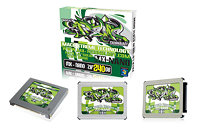- Joined
- Oct 9, 2007
- Messages
- 47,670 (7.43/day)
- Location
- Dublin, Ireland
| System Name | RBMK-1000 |
|---|---|
| Processor | AMD Ryzen 7 5700G |
| Motherboard | Gigabyte B550 AORUS Elite V2 |
| Cooling | DeepCool Gammax L240 V2 |
| Memory | 2x 16GB DDR4-3200 |
| Video Card(s) | Galax RTX 4070 Ti EX |
| Storage | Samsung 990 1TB |
| Display(s) | BenQ 1440p 60 Hz 27-inch |
| Case | Corsair Carbide 100R |
| Audio Device(s) | ASUS SupremeFX S1220A |
| Power Supply | Cooler Master MWE Gold 650W |
| Mouse | ASUS ROG Strix Impact |
| Keyboard | Gamdias Hermes E2 |
| Software | Windows 11 Pro |
Mach Xtreme Technology Inc., a worldwide leader in top performance, high reliability and user-friendly designed PC components, today unveiled MX-NANO Series 1.8" PATA SSD with 256MB cache memory which makes MLC (multi-level cell) NAND-based storage an affordable offering for notebook users demanding performance and energy efficiency at an attractive price point.
The new MX-NANO Series of 1.8" PATA SSDs that are ideal for upgrading popular notebooks based on 50-pin, 44-pin or ZIF PATA interface. Combined with industry's leading 256MB cache memory and ultra-fast access times, these new SSDs deliver double or even triple the performance of the default hard drives in most current notebooks, resulting in substantially faster boot-up, application load and shutdown speeds. It is one of the fastest and easiest ways to upgrade dozens of different notebooks and UMPCs to higher performance and more local storage (up to 240GB).

The MX-NANO drive delivers best-in-class read and write speeds clocking in at up to 120MB/s read and 90MB/s write along with the maximum of 5,200 IOPS and superior durability (1.0 million MTBF) compared to previous generation notebook drives. Available in 50-pin, 44-pin and ZIF interface flavors and capacities of 30GB, 60GB, 120GB and 240GB, Mach Xtreme Technology MX-NANO SSDs offer ample room for all your data and comes backed with 1 Year Warranty and outstanding after-sales service.
MX-NANO Series 1.8" PATA SSD at A Glance:
View at TechPowerUp Main Site
The new MX-NANO Series of 1.8" PATA SSDs that are ideal for upgrading popular notebooks based on 50-pin, 44-pin or ZIF PATA interface. Combined with industry's leading 256MB cache memory and ultra-fast access times, these new SSDs deliver double or even triple the performance of the default hard drives in most current notebooks, resulting in substantially faster boot-up, application load and shutdown speeds. It is one of the fastest and easiest ways to upgrade dozens of different notebooks and UMPCs to higher performance and more local storage (up to 240GB).

The MX-NANO drive delivers best-in-class read and write speeds clocking in at up to 120MB/s read and 90MB/s write along with the maximum of 5,200 IOPS and superior durability (1.0 million MTBF) compared to previous generation notebook drives. Available in 50-pin, 44-pin and ZIF interface flavors and capacities of 30GB, 60GB, 120GB and 240GB, Mach Xtreme Technology MX-NANO SSDs offer ample room for all your data and comes backed with 1 Year Warranty and outstanding after-sales service.
MX-NANO Series 1.8" PATA SSD at A Glance:
- 1.8" PATA (44-pin, 50-pin, ZIF) MLC Solid State Drive
- 256MB SDRAM cache memory
- Max. Read Performance up to 120MB/s (120G/240G)
- Max. Write Performance up to 90MB/s (120G/240G)
- I/O per second of 5,200 IOPS
- Power consumption: stand-by 0.5W / active 1.3W
- Life expectancy 1.0 million hours MTBF
- 50-pin interface capacity:
30GB (MXSSD1MNANO50-30G),
60GB (MXSSD1MNANO50-60G),
120GB (MXSSD1MNANO50-120G) and
240GB (MXSSD1MNANO50-240G) - 44-pin interface capacity: 30GB (MXSSD1MNANO-30G),
60GB (MXSSD1MNANO-60G),
120GB (MXSSD1MNANO-120G) and
240GB (MXSSD1MNANO-240G) - ZIF interface capacity:
30GB (MXSSD1MNANOZ-30G),
60GB (MXSSD1MNANOZ-60G),
120GB (MXSSD1MNANOZ-120G) and
240GB (MXSSD1MNANOZ-240G) - Warranty: 1 Year
View at TechPowerUp Main Site


 )
)